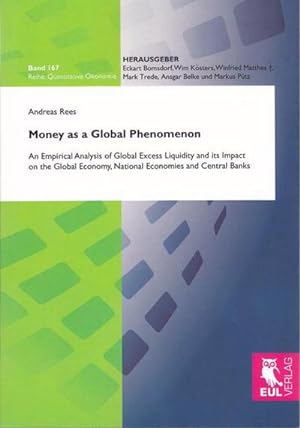money global phenomenon empirical di rees andreas (1 risultati)
Tipo di articolo
- Tutti gli articoli
- Libri (1)
- Riviste e Giornali
- Fumetti
- Spartiti
- Arte, Stampe e Poster
- Fotografie
- Mappe
-
Manoscritti e
Collezionismo cartaceo
Condizioni
- Tutte
- Nuovi
- Antichi o usati
Legatura
- Tutte
- Rilegato
- Brossura
Ulteriori caratteristiche
- Prima edizione
- Copia autografata
- Sovraccoperta
- Con foto
- No print on demand
Paese del venditore
Valutazione venditore
-
Money as a Global Phenomenon : An Empirical Analysis of Global Excess Liquidity and its Impact on the Global Economy, National Economies and Central Banks
Editore: Josef Eul Verlag Gmbh
ISBN 10: 3844100768ISBN 13: 9783844100761
Da: AHA-BUCH GmbH, Einbeck, Germania
Libro Print on Demand
Taschenbuch. Condizione: Neu. nach der Bestellung gedruckt Neuware - Printed after ordering - The large increase in international financial integration has been one of the most striking aspects of the global economy over past decades. In recent years, the rise of capital flows between countries has been particularly dramatic. Has money therefore become a global phenomenon due to financial globalization Excessive money growth in one country may spill over to other economies, thereby resulting in synchronously rising monetary aggregates across a variety of countries. As a result, a common and therefore global liquidity force would exist which significantly affects domestic macroeconomic and financial variables. In this work, various econometric approaches are implemented for the G7 countries and the EMU. One major contribution is the estimate of a global Structural Factor Augmented VAR model. Accordingly, common money supply shocks significantly influence the following variables on a worldwide level: real GDP, prices, the short-term interest rate and house prices. Innovations to the common money supply also trigger significant reactions of domestic variables like broad money, economic activity, CPI and residential property prices. These effects do not primarily occur in small open economies but in the US and the euro zone. There is some evidence that global excess liquidity contributed to the strongly increasing US house prices in the run-up to the recent financial crisis. The obtained empirical evidence in this work appears to contradict at least partly the prevalent monetary transmission mechanism in traditional economic models. National variables such as short-term interest rates and money supplies may not be the sole channels by which central banks affect real quantities and prices. A new kid on the block in form of global liquidity seems to have emerged especially for large countries with huge and deep financial markets.


